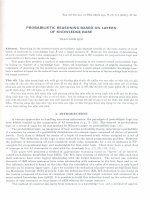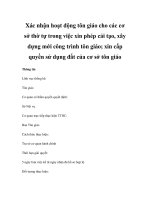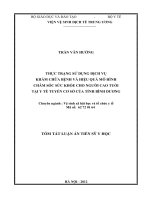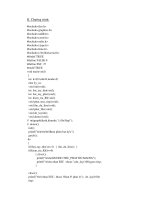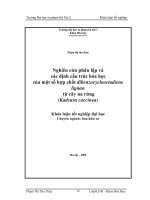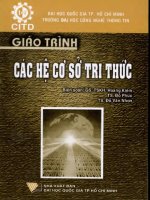Lập luận xác xuất dựa vào các tầng của cơ sở tri thức. pot
Bạn đang xem bản rút gọn của tài liệu. Xem và tải ngay bản đầy đủ của tài liệu tại đây (4.3 MB, 8 trang )
T'l-p chi Tin h9C
va
Dieu
khi€n h9C,
T. 17,
S.2
(2001), 27-34
PROBABILISTIC REASONING BASED ON LAYERS
OF KNOWLEDGE BASE
TRAN DINH QUE
Abstract. Reasoning in the interval-valued probabilistic logic depends heavily on the basic matrix of truth
values of sentences in a knowledge base 8 and a target sentence
S.
However, the problem of determining
all such consistent truth value assignments for a set of sentences is NP-complete for propositional logic and
undecidable for first-order predicate logic.
This pap er first presents a method of approximate reasoning in the interval-valued probabilistic logic
by basing on "byers" of a knowledge base. Then, we investigate the method of slightly decreasing the
complexity of reasoning via the maximum entropy principle in a point-valued probabilistic knowledge base.
Such", method is based on the reduced basic matrix constructed from sentences of the knowledge base without
the target sentence.
Tom tlit. Lap luan trong logic xac sufit gia trj khodng phu thuoc rat nhieu vao ma tr~n
CO'
bin ciia cac gia
tri chan ly cila cac cfiu trong co' so' tri thirc
8
va cau dich
S.
Tuy nhien, bai toan xac dinh tat
d.
nh img
phep gan gia tr] chin ly phi mfiu thuin cho mot t~p ho-p cau
111.
NP-day dtl doi vo'i logic menh de va khOng
quye
t
djnh
ducc
doi voi logic vi
t
ir cap
l.
Bai bao nay tru'o'c het trlnh bay mot phtro'ng ph ap l%p lu an xap xi trong logic xac sufit gia trj khodng
bhg each
dua
vao "cac t'ang" cd a
CO'
so' tri
t
hirc, Sau do chiing ta se xem xet met phtro'ng ph ap lam gidm
mi?t chut di? phirc
t
ap cil a l%p luan du'a tren nguy en ly entropy toi dai trong
CO'
so' tri thrrc xac suat gia tr]
die'm. Phiro'ng ph ap l%p luan nhu' v~y du'a tren ma tr~n co' ban rut gon du'C!cxay dung
t
ir cac cau trong co'
so' tri thu'c kh ong bao gem cau dich.
1. INTRODUCTION
In various approaches to handling uncertain information, the paradigm of probabilistic logic has
been widely studied in the community of AI reseachers (e.g., [1-
13]).
The interest in probabilistic
logic as a research topic for AI was sparked by Nilsson's paper on probabilistic logic
[111.
The probabilistic logic, an integration of logic and the probability theory, determines a probability
of a sentence by means of a probability distribution on a sample space composed of
classes of possible
worlds.
Each class is defined by means of a tuple of consistent truth values assigned to a set of
sentences. The deduction in this logic is then reduced to the linear programming problem. However,
the problem of determining all such consistent truth value assigments for a set of- sentences is NP-
complete for propositional logic and undecidable for first-order logic. There have been a great deal
of attemps in the AI community to deal with the drawback (e.g.,
[1], [8]' [10]' [13]).
This paper first proposes a method of approximate reasoning based on "layers" of an interval-
valued probabilistic knowledge base (iKB). The first layer consists of elements of the iKB such that
their sentences have someJogical relationship with the target sentence. The second one contains
elements of iKB whose sentences have some relationship with sentences in the first layer and so on,
Our inference method is based on the idea that the calculation of a value of a sentence is only based
directly on its nearest upper layer. Later we consider the deduction of point-valued probabilistic logic
via Maximum Entropy (ME) principle, Like the deduction from iKB, ME deduction is also based on
the matrix composed of vectors of consistent truth values of the target sentence and sentences in a
point-valued knowledge base (pKB). It is possible to build this deduction based on the reduced basic
matrix of only sentences in some layers of pKB without t-he target sentence,
The method of constructing layers from sentences in a knowledge base and a method of approx-
28
TRAN DINH QUE
imate reasoning based on them will be presented in the next section. Section 3 presents a method
of reducing the size of the basic matrix in the pointed probabilistic reasoning via ME. Our approach
is to construct the basic matrix of the sentences in the related layers without referring to the goal
sentence. Some conclusions and discussions are presented in Section
4.
2. APPROXIMATE REASONING BASED ON LAYERS
OF A KNOWLEDGE BASE
2.1. Entailment problem in probabilistic logic
This section overviews the entailment problem of the interval-valued probabilistic logic
[3]
and
of the point-valued probabilistic logic proposed by Nilsson
[11].
Given an iKB
8
=
{(Si,Ii)
Ii
=
1,
,l},
in which
Si (i
=
1, ,
l)
are sentences,
I;
(i
=
1, ,
l)
are subintervals of the unit interval
[0,1];
and a target sentence
S.
From the set of sentences ~
=
{S
1, ,
SI, SI+
1},
(SI+
1
=
S),
it is possible
to construct a set of classes of possible worlds. Every class is characterized by a vector of consistent
truth values of sentences in ~. In this section, we suppose that
11
=
{Wi,
,wd
is the set of all~-
classes of possible worlds
and
(Ulj, , Ulj, UI+lj)t
is a column vector of the truth values of sentences
w.r.t.
Sl, , SI, SI+l
in the class
Wj.
Let
P
=
(pi, ,
Pk)
be a probability distribution over the sample space
11.
The truth probability
of a sentence
S;
is then defined to be the sum of probabilities on possible world classes in which
S;
is true, i.e.,
7r(Si)
=
UilPl
+ +
UikPk
or
7r(Si)
=
L
PJ·
W
iPS,
We can write these equalities in the form of the following matrix equation
II
=
UP,
where II
=
(7r(Sd, , 7r(St) ,7r(S))t,
P
=
(pi,
,Pk)t
and
U
=
(Uij) (i
=
1, ,
l +
1,1
=
1, ,
k).
The matrix
U
will be called the
basix matrix
of ~.
The probabilistic entailment problem is reduced to the linear programming one finding
a
=
min
7r(S),
f3
=
max
7r(S),
where
7r(S)
=
UI+l,lPl
+ +
UI+l,kPk,
subject to constraints
{
':~U~Pd
+
U"P,_E
I,
(i~l, ,I)
L
PJ -
1,
PJ ~
0 (1 - 1,
,k).
j=1
We denote the interval
[a,
f3]
by
F(S,
8),
and write
8
f
(S, F(S,
8)).
In the special case, when 8 is the point-valued probabilistic knowledge base (pKB), i.e., all
I,
are points
ai
in [0,
-1],
constraints become equalities
{
. 7r:
=
U~P1
+ +
=.
ai
(i
=
1,
,l)
L
PJ -
1,
PJ ~
0 (1 - 1,
,k).
j=l
PROBABILISTIC REASONING BASED ON LAYERS OF KNOWLEDGE BASE
29
However, in general,
F(S,
B)
is not to be a point value. Some assumption is added to the constraints
to derive a point value for a target sentence. The Maximum Entropy (ME) principle is usually used
for such a deduction. We will return to this investigation in Section 3.
2.2.
Layers of knowledge base
This subsection is devoted to presenting a procedure to produce layers of a knowledge base.
Suppose that
B
=
{(Si, Ii)
Ii
=
1, ,
I}
is an iKB, in which
S,
are propositional sentences and
Ii
are interval values of sentences
Si; S
is any target sentence we would like to calculate its probability
value.
The reasoning for deriving the probabilistic value of the sentence
S
from the knowledge base
B
depends strongly on the basic matrix of truth values of a subset of sentences in ~'
=
{Sl, , Sl}
that have some logical relationship with the target sentence. We will characterise the relationship by
layering the set of sentences in the knowledge base.
A
subset
B'
of
B
is
sufficient for S
if the probabilistic values of
S
deduced from Band
B'
are
the same.
It means that if
B
f-
(S, I)
and
B'
f-
(S, I')
then
1= I'.
Denote
atom(
q,)
the set of atoms occuring in the sentence
q,
and
atom(
<1»
=
U1>E<1>
atom(
q,)
the
set of all atoms in sentences in
<1>.
Example
1.
atom(A
>
B /\
C)
=
{A,
B, C}.
atom( {A /\
B,
C
>
-,D})
=
{A,
B,
C,
D}.
The following note shows us the meaning of introducing the notion of
atom.
If
B'
is a subset of
B
such that
atom(B'
U
{S})
n
atom(B - B')
=
0,
then
B'
is sufficient for
S.
We now consider a procedure to produce layers of a knowledge base based on a logical dependence
between its sentences with the sentence
S.
Layers of sentences in ~ are constructed recursively as follows:
Lg
=
{S},
Lf
=
{q,
I
q,
E~,
q,
rf:-
Lg
and
atom(q,)
n
atom(Lg)
¥-
0},
L~
=
{q,
I
q,
E~,
q,
rf:-
u;=oLf
and
atom(q,)
n
atom(Lf)
¥-
0}
L~
=
{q,
I
q,
E~,
q,
rf:-
U7:~
Lf
and
atom(q,)
n
atom(L~_l)
¥-
0},
With respect to each
L~,
let
B;
=
{(q"
11»
I
(q,'/1»
E
Band
q,
E
L~},
n ~
o.
Note that if
S rf:-~',
then
Bg
=
{(S,
[0,1]);
otherwise
Bcf
=
{(S,Is)
I
(S,Is)
E
B}.
We call the subset
8;[
to be
nth-layer
of the knowledge base
B
w.r.t.
S.
If
q,
ELi,
the layer
Bl+1
is called the
nearest upper-layer
of the sentence.
It is easy to see that there always exists a number
no
such that
L~o
¥-
0
but
L~o+l
=
0.
We
denote
B
-
uno
B
S
suf(S) -
i=O i .
It is clear that Bsuf(s) is a sufficient subset for
S.
Consider the following illustrating example.
Example
2.
Given a knowledge base
30
TRAN DINH QUE
8
=
{B
+
A: [.9,1]'
D + B :
[.8, .9]'
A A C : [.6, .8]'
D :
[.8,1]'
C: [.2, .7]}
and a target sentence
A.
The knowledge base can be layered into subsets with the target sentence
A
L~ = {A}, 8~ = {A : [0, I]}
L1
= {B
+
A, A
A
C}, 8~ = {B
+
A :
[.9,1]'
A
A
C :
[.6, .8]}
L~ = {D
+
B, C}, 8~ = {D
+
B :
[.8, .9]'
C :
[.2, .7]}
L~
=
{D},
8:
=
{D :
[.8, I]}
Thus, the sufficient subset for
A
is
8"uf(A)
= 8.
Similarly, layering can be performed for a point-valued probabilistic knowledge base.
2.3. Approximate solution based on layers
In the case a knowledge base is large, it is not easy to derive the smallest interval value for a
target sentence
S
from
8
81l
f(s)'
Layers gives us a method of calculating an approximate value. The
idea of approximate reasoning is that the probabilistic value of each sentence is updated by deriving
its value based on the nearest upper-layer of this sentence. And when all sentences of the nearest
upper-layer of the target sentence are updated, its value is then calculated. We now forrn alise the
above presentation.
Without loss of generality, we suppose that 8 is a sufficient knowledge base and
S
is a target
sentence. It is layered into subsets
8g,
8
f, ,
8:
0
,
where
8~~
is the highest layer in the knowledge
base. Remind that
Lf
(i =
1, ,
no)
are subsets of sentences w.r.t.
8p.
Update
of a sentence
</J
is recursively defined as follows:
(i) For all
</J
E
L~o'
</J
is updated;
(ii)
</J
E
Lf,
(i
<
no), is updated if all
'if;
E
L7+1
are updated and
8(~+1,u)
r-
(</J,1",),
where
8
s
8s
(i+1,u)
is the updated layer of
i+1'
If
81'
is updated into
8ri,u)
and
8ri,u)
r-
(S, Is),
then
Is
is the approximate value for
S.
Thus, the approximate calculation of interval value for a sentence consists of three steps:
1. Divide the knowledge base into layers with the lowest layer being the target sentence
S.
2. Update the values for sentences of 8
i
-
1
from the nearest upper-layer 8
i
.
This process starts
from
i
=
no till
8
1
is updated into
8("~,u)'
3. Calculate the value for
S
from
8(~,u)'
Example 3. (continued) In Example 2, we have constructed the layers of the knowledge base. If we
base on the whole 8
8Uf
(
A),
it is necessary to build a 6
X
14-basic matrix of 6 rows and 14 columns. It.
is possible to calculate the value for
A
according to the above approximate method.
In the process of updating,
D
+
Band
B
+
A
are stable, i.e., their values are
[.8,
.9] and [.9,1]'
respectively. Since the value of Cis [.2, .7]'
AAC
is updated to [.6, .7]. Thus, a value of
A
is deduced
from the 1
th
updated layer
8(i,u)
=
{B
+
A :
[.9,1]'
A
A
C : [.6, .7]}.
The basic matrix for sentences I;
= {B
+
A, A A
C,
A}
is
(
1 1 1
0)
1
000
1 0 1 0
PROBABILISTIC REASONING BASED ON LAYERS OF KNOWLEDGE BASE
31
We need to compute
on the domain determined by
{
.9::;
P
1
+
P2
+
P3
<
1
.6::;
Pl
< .7
P
1
+
P2
+
P3
+
P4
=
1
The value of
A
is then
[.6,1].
We compare now the computable value with a value derived from the anytime deduction proposed
by Frish and Haddawy
[8].
Anytime deduction is based on a set of thirty two rules enumerated from
(i) to (xxxii). In the above example, applying (xx) first to
D :
[.8,1]
and
D
+
B :
[.8, .9]
yields
B :
[.6, .9];
then combining it with
B
+
A :
[.9,1]
via the rule (xx) results to
A :
[.5,1].
In the
same way, combining
C : [.2, .7]
and
A :
[0,1]
via the rule (xxv) gives
A 1\
C : [0, .7]
and then with
A 1\
C : [.6, .8]
via (xvii) gives
A 1\
C : [.6, .7];
applying (xxvi) to this result yields
A :
[.6,1].
Applying
(xvii) to two ways of computation of
A,
we have
A :
[.6,1].
The derived interval equals to the interval
value of
A
deduced by our method of approximate reasoning.
3. MAXIMUM ENTROPY DEDUCTION BASED ON THE REDUCED
BASIC MATRIX
In this section, we investigate a method ofreducing the complexity of computation in applying the
Maximum Entropy Principle for deriving a point value for a sentence from a point-valued probabilistic
knowledge base.
3.1.
Maximum
Entropy Deduction
We first review a technique named Maximum Entropy Principle [11] to select a probability distribution
among distributions holding some initial conditions given by a knowledge base.
Suppose that
8
= {(5
i,O:i)
Ii
= 1,
,I}
is pKB and
5
is a sentence
(5
=f.
5
i
,
i
=
1, ,
I).
As presented in Section
2,
denote
F(5,
8)
the
set of values of
7r(5)
=
LWil=S Pi
=
UI+l,lPl
+ +
UI+l,kPk,
where
P
=
(pl,'" ,pd
varies in the
domain defined by conditional equation
II
=
U+ P,
(1)
where
II
=
(1,0:1,""
o:t}t
and
U+
is the basic matrix composing of columns of truth values of
sentences
51, ,
5
1
,5
1
+
1
(5
1
+
1
=
5)
with the first row being units.
According to Maximum Entropy Principle, in order to obtain a single value for
5,
we must select
a distribution
P
such that the following optimization problem holds
k
H(p)
= -
L
P
J
logPl
+
max,
(2)
J=l
where
P
subjects to constraints determined by the conditional equation
(1).
Suppose that
(pl,' ,Pk)
is a solution of the above problem. Then the probability of
5
is denoted
by
F(5,
8) =
UllPl
+ +
UI+l,kPk'
Let
ao, a
1,
,al
be parameters for rows of
U+.
Each
Pi
is defined according to
aJ
by means of
ith-column of
U+
Pi
= ao
II
aJ
(i=1, ,k).
(3)
Uij=l,l~i~l
32
TRAN DINH qUE
From the initial conditions of the knowledge base, we can compute
a,
and then
Pi.
Thus the point
probability value of
S
is then derived. We call the deduction based on the Maximum Entropy Principle
to be the
Maximum Entropy deduction
or shortly ME deduction.
3.2. Maxirnum Entropy Deduction with the Reduced Basic Matrix
As presented above, the ME deduction is based on the basic matrix constructed from the target
sentence and all sentences in the initial knowledge base. The larger the basic matrix is, the more
complex the computation is. In fact, coefficients
ai
in (3) are only related to the matrix of truth
values of sentences in the knowledge base. The complexity is slightly decreased if ME deduction is
based on the basic matrix constructed only from sentences of the knowledge base without the target
sentence.
As presented in Subsection 2.2, the probabilistic inference only depends on the sufficient subset'
for the target sentence. Without loss of generality, we suppose that
B
=
Bsuf(s),
0
=
{Wl,".
,wd
is a set of possible world classes determined by·~
=
{S
l,
,Sd
and
U+
is the
reduced basic matrix
of sentences in ~ with the first row being units.
In each class
Wi, S
can have either one truth value true/false or both truth values true and false.
For ease of presentation, we suppose that on classes
W
l,
,W
rn
,
the sentence
S
gets one truth value
and on
Wm+l,'" ,Wk,
S
has both values true and false. Thus, the ectende d set of possible world
classes W.r.t. ~
U
{S}
has the form
O+=FUE,
where
F
=
{WI, ,wrn}
and
E
=
{w;:;'+l! W;:;:'+l' ,wt ,w;}.
We have the following proposition.
Proposition 1.
Suppose that P is a probability distribution satisfying ME principle on
O.
We have
tt
(S)
=
L
Pi
+ ~
L
Pi . (4)
w;i=S,w"I:<:;i:<:;m w;i=S,m+l:<:;i:<:;k
P
f
S
+ - (
I I
+ - + -)'
h b b bili di ibuti n+
roo.
upposep -
PI""'Prn'Prn+I'Pm+I"",Pk,Pk
is
t
epro a a
ility
istrr ution
on ••
satisfying ME and (1). According to the method of constructing this distribution, we have
+ - - +- -
Pm+l - Pm+l!'"
,Pk - Pk'
Therefore, if
P
=
(PI, ,
Pm,
Prn+l, ,
Pk)
is the probabilistic distribution on 0 satisfying (1) and
ME, then
Pi
=
P: (i
=
1, ,
m),
Pi
=
2Pt
(i
2
m
+
1).
It is easy to derive (4) from these equalities. The proposition is proved.
In summary, the computation of the point value for a sentence
S
via ME consists of three steps:
1. Construct the sufficient subset for
S
to eliminate unnecessary information.
2. Find an entropy-maximizing
P
based on the reduced basic matrix
U+
of the sentences in the
sufficient subset.
3. Calculate
7r(S)
via the equality (4).
Example
4. Given a knowledge base
B
=
{A :
ai,
A
>
B :
a2,
B
>
C :
a3}
and a target sentence
C.
It is clear that
B
=
BHUf(C)'
The reduced basic matrix for the set of sentences in
B
with the first
PROBABILISTIC REASONING BASED ON LAYERS OF KNOWLEDGE BASE
33
row of units is
1 1 1
1 0 1
1 1 0
001
in which the second row is the truth values of
A,
the third and fourth ones are of
A
>
Band
B
-+
C,
respectively. Thus, there are five classes of possible world
WI, ,W5
corresponding to five column
vectors (eliminating the first row):
VI
=
(l,l,l)t,
V2
=
(1,1,0)t,
V3
=
(0,1,0)t,
V4
= (i.o.u',
V5
=
(O,l,l)t.
Components of
Pi
are written in the form
with
(ao,
aI,
a2, a3)
satisfying the system of equations
{
aOala2a3
+
aOala2
+
aOala3
+
aOa2a3
=
QI
aOala2a3
+
aOala2
+
aOa2
+
aOa2a3
= Q2
aOala2a3
+
aOala3
+
aOa2a3
=
Q3
aOala2a3
+
aOala2
+
aOa2
+
aOala3
+
aOa2a3
=
1
Solving yields
ao =
(1 - QI)(l - Q2)(1 - QI
+
Q2 - Q3)/(QI
+
Q3 - 1)(Q2 - Q3)'
al
=
(Q2 - Q3)/(1 - Qd,
a2
=
(QI
+
Q3 - 1)(Q2 - Q3)/(1 - Q2)(1 - QI
+
Q2 - Q3),
a3
=
(1
+
QI
+
Q3)/(1 - QI
+
Q2 - Q3).
Thus, the entropy-maximizing P is given by:
(
(Q2 - Q3l~(~IQ: Q3 - 1) )
P
=
1 - QI
1-
Q2
(1 - Qd(QI
+
Q3 - 1)/(1 - QI
+
Q2 - Q3)
Since
C
has one true value on
WI,
two truth values in classes
W4
and
W5
(false value on
W2,W3),
the
probability of
A
is then
4. CONCLUSION
This paper has presented a method of layering a knowledge base based on the logical relationship
between sentences of the knowledge base with a target sentence. By means of layers, we can perform
approximate reasoning in order to derive an interval value for the sentence. Our approximate method
is different from the anytime deduction proposed by Frish and Haddawy [8]. While our one is based
on the process of updating of all sentences before deriving an interval value for the target sentence,
their anytime deduction is based on a set of rules.
34
TRAN DINH QUE
We have also presented a method of calculating the point probabilistic value of a sentence via
the Maximum Entropy Principle by not referring to the target sentence when constructing the basic
matrix. This method slightly decreases the size of the matrix in the computation process.
We have presented a comparative example between our approximate method and the anytime
deduction proposed by Frish and Haddawy. A complete comparison of this approximate method with
the other ones will be a topic of our further work.
Acknowledgement.
I am greatly indebted to my supervisor, Prof. Phan Dinh Dieu, for invaluable
suggestions.
REFERENCES
[1] K. A. Anderson. Characterizing consistency in probabilistic logic for a class of Horn clauses.
Mathematical Proqramrninq
66
(1994) 257-271.
[2] F. Bacchus, A.
J.
Grove,
J.
Y. Halpern and D. Koller. From statistical knowledge bases to
degrees of belief,
Artificial Intelligence
81
(1-2) (1996) 75-143.
[3] P. D. Dieu, On a theory of interval-valued probabilistic logic,
Research Report, NCSR Vietnam,
Hanoi,
1991.
[4] P. D. Dieu and P. H. Giang, Interval-valued probabilistic logic for logic programs,
Journal of
Computer Science and Cybernatics
10
(3) (1994) 1-8.
[5] P. D. Dieu and T. D. Que, From a convergence to a reasoning with interval-valued probability,
Journal of Computer Science and Cybernetics
13
(3) (1997) 1-9.
[6] R. Fagin,
J.
Y. Halpern, and N. Megiddo, A logic for reasoning about probabilies,
Information
and Compuation
81
(1990) 78-128.
[7] R. Fagin and
J.
Y. Halpern, Uncertainty, Belief and Probability,
Computational Intelligence 1
(1991) 160-173.
[8] A. M. Frish and P. Haddawy, Anytime deduction for probabilistic logic,
Artificial Intelligence
69
(1994) 93-122.
[9] R. Kruse, E. Schwecke, and
J.
Heinsohn,
Uncertainty and Vagueness in Knowledge Based Sys-
tems,
Springer-Verlag, Berlin - Heidelberg,
1991.
[10]
R. T. Ng and V. S. Subr ahm anian, Probabilistic logic programming.
Information and Compu-
tation
101
(1992) 150-201.
[11]
N.
J.
Nilsson, Probabilistic logic,
Artificial Intelligence
28
(1986) 71-78.
[12]
T. D. Que, About semantics of probabilistic logic, Submitted to
Computer Science and Cyber-
netics.
[13]
P. Snow, Compressed constraints in probabilistic logic and their revision,
Uncertainty in Arti-
ficial Intelligence
(1991) 386-391.
Received November
is,
1999
Department of Information Technology,
Posts and Telecommunications Institute of Technology,
Hanoi, Vietnam.
